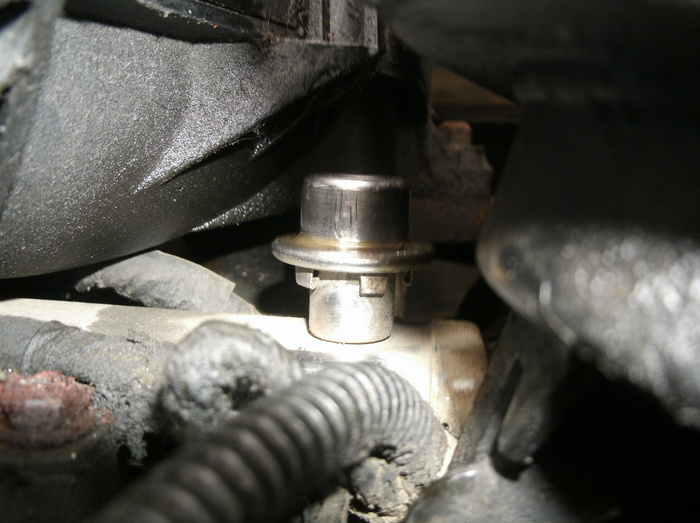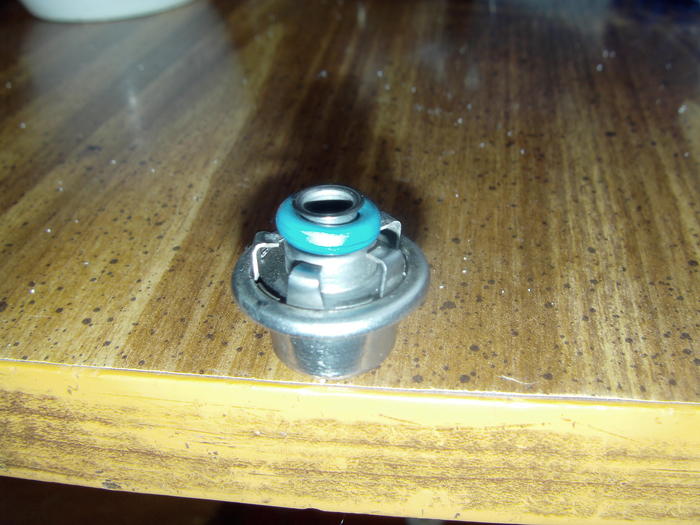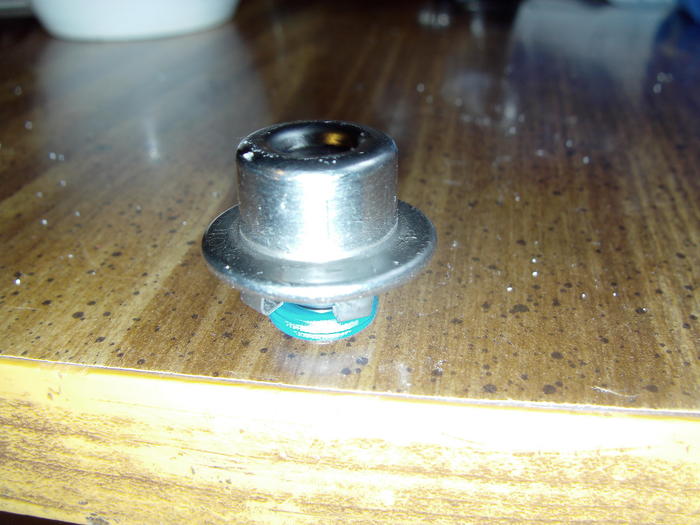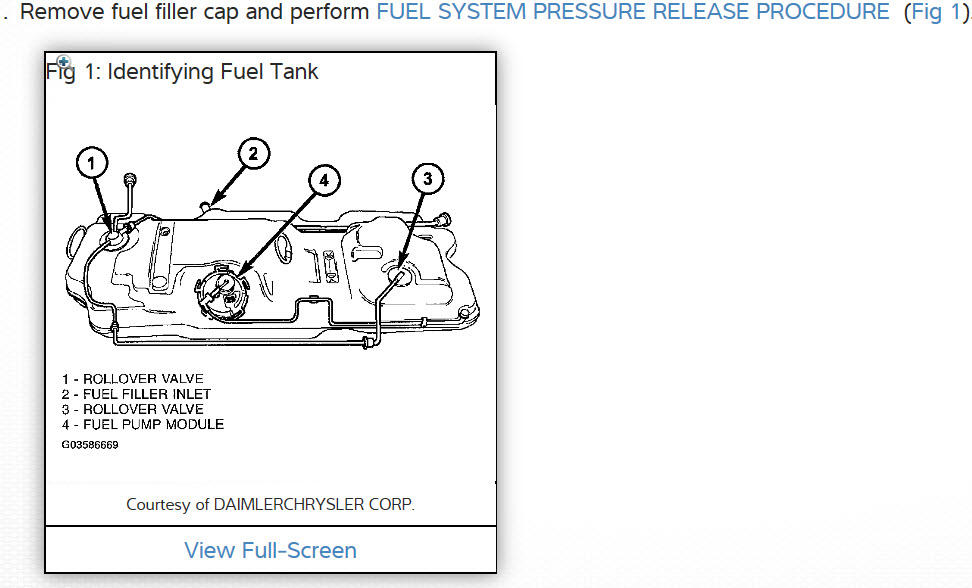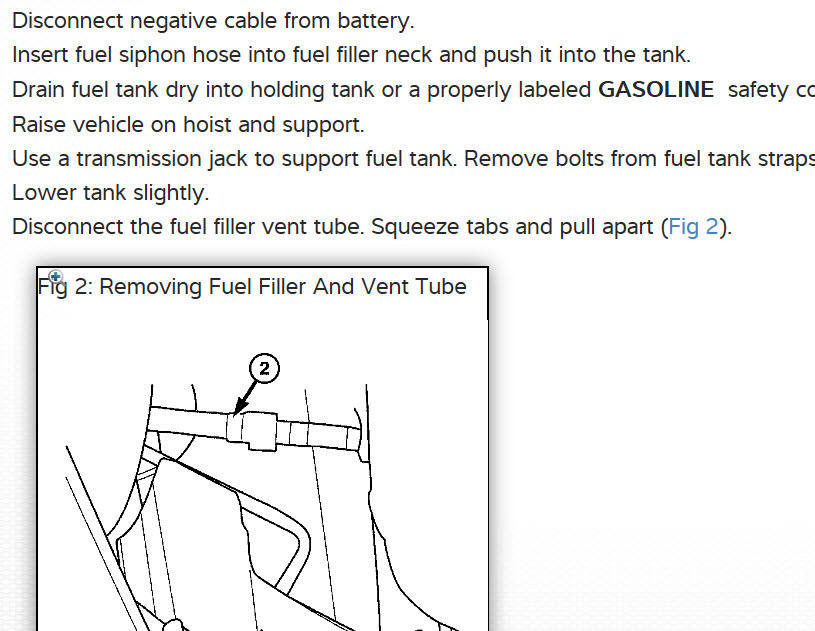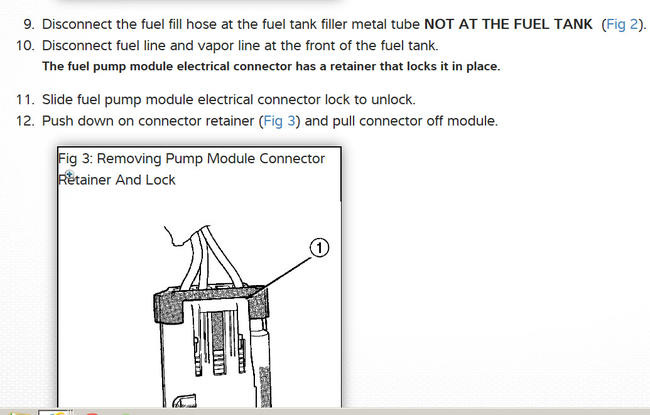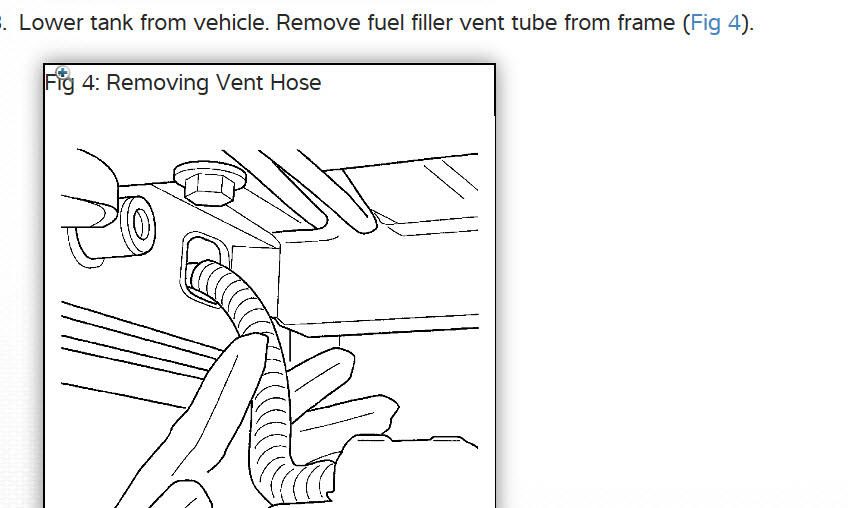Monday, February 14th, 2011 AT 12:41 AM
SPONSORED LINKS
Fuel leak
16 Replies
That's the fuel pressure regulator. GM has a huge problem with them but Chrysler has almost no trouble. It appears rust is the problem. I don't even see that much rust up here in WI, the road salt capital of the world. To prevent problems I would replace the entire fuel rail. Since this is such an uncommon problem, there's a real good chance you'll find a good one in a salvage yard.
Caradiodoc
Caradiodoc
SPONSORED LINKS
Was this helpful?
Yes
No
Monday, February 14th, 2011 AT 12:52 AM
I have to disagree with your assessment here. I may have to replace the fuel rail but I saw this post by a guy with a 2002 Dodge Caravan that is very similar to what I am facing. So I emailed him with the same pic. He didn't describe in much detail how he took it apart. It is not the fuel regulator as it has no vacuum hose. Mitchell on Demand calls it a test port. There seems to be a difference of opinion what it is. I will get his opinion before I proceed. Thanks for your help!
Was this helpful?
Yes
No
+3
Monday, February 14th, 2011 AT 1:45 AM
I got a very good man that has experience with this problem and said it can be fixed by disassembling the fuel rail and taking the cap off and putting an injector o-ring and reassembling it. Thanks for your help here!
Was this helpful?
Yes
No
+7
Monday, February 14th, 2011 AT 3:46 AM
There is no longer a vacuum hose on the regulator. Older systems used that to relax the regulator and lower fuel pressure when manifold vacuum went up. That keeps the difference between the two forces constant to prevent a rich coast-down condition.
You're right though, that isn't the regulator. That is part of the fuel pump assembly now. If it was the regulator there would be a metal return tube under it.
That doesn't look like any test port I've ever seen. It should look like a tire valve on the 3.3L engine. The service manual shows three different pressure testing adapter harnesses and two different engines. One looks like what I use with my 3.0L engines. One looks like a hose with the typical 3.3L test port, and the last one, I assume, is for the 4 cylinder engine. Nothing in the manual identifies the item in your photo as a test port.
That last adapter looks like it would connect to a quick coupler-type hose and it looks like that could be what is in your photo. I wonder if that is a cap on the test port. The metal hooks under the cap would be spread apart with a quick-disconnect tool to release the cap. That tool is not shown in the manual. If that really is a test port, I wonder why they show test adapters in the manual.
Since there's no fuel return hose, how is the air bled out to get fuel to the injectors. Could this be a bleeder valve? You would think they would mention it in the manual. What happens if you press down on it?
Caradiodoc
You're right though, that isn't the regulator. That is part of the fuel pump assembly now. If it was the regulator there would be a metal return tube under it.
That doesn't look like any test port I've ever seen. It should look like a tire valve on the 3.3L engine. The service manual shows three different pressure testing adapter harnesses and two different engines. One looks like what I use with my 3.0L engines. One looks like a hose with the typical 3.3L test port, and the last one, I assume, is for the 4 cylinder engine. Nothing in the manual identifies the item in your photo as a test port.
That last adapter looks like it would connect to a quick coupler-type hose and it looks like that could be what is in your photo. I wonder if that is a cap on the test port. The metal hooks under the cap would be spread apart with a quick-disconnect tool to release the cap. That tool is not shown in the manual. If that really is a test port, I wonder why they show test adapters in the manual.
Since there's no fuel return hose, how is the air bled out to get fuel to the injectors. Could this be a bleeder valve? You would think they would mention it in the manual. What happens if you press down on it?
Caradiodoc
Was this helpful?
Yes
No
+3
Monday, February 14th, 2011 AT 5:13 AM
Sorry our replies overlapped. Older Intrepids had a problem with injector o-rings shrinking in cold weather and leaking in the fuel rail. Now you have my curiosity. Is this really a test port? Why does the rail have to be disassembled? Are you familiar with the tools to disconnect fuel and AC hoses? Looks like they would work on this item.
Caradiodoc
Caradiodoc
SPONSORED LINKS
Was this helpful?
Yes
No
+2
Monday, February 14th, 2011 AT 5:43 AM
Good Questions and great answers caraiodoc! The more I dig into this the more I find it is somewhat unusual but it seems that other Chrysler products have had this problem. I found a jeep model with this same device on the frame rail and a guy in your forum who has a 4 cylinder 2002 caravan with a this device also.
https://www.2carpros.com/questions/dodge-caravan-2002-dodge-caravan-fuel-rail-leak
I am an advanced back yard mechanic who has access to professional mechanics and some of these special tools. I know how to pull the fuel pump relay and run the fuel out and know the precautions it takes to get this job done. This member jrr4948 emailed me this response after I sent him the picture that you saw:
If you are only leaking fuel from the cap in the picture you may be in luck! I had the same problem. You may not need a new rail. You will have to take off the entire fuel rail which is not that hard. Once you disconnect the fuel supply and the bolt or bolts (I forget) that hold it in place the entire rail will pull out in one shot. Make sure you apply even pressure on both sides. It is held in with “blue” silicone type circular donut seals. Each fuel injector has one blue seal on the injector. Once you get it out you can carefully pry off the cap on the rail. Under this cap is the same exact donut seal, same size and everything. I’m sure you can find a parts supply that will sell them to replace. I swapped one of the injector seals with the cap seal and for whatever reason it worked for me. That was over a year maybe 2 years ago. If you can find the seals, they are probably cheap so you might as well replace them while it is out. Carefully snap the cap back over the seal. You may have to bend the tabs back into place to get a firm fit. Carefully install the seals and press back the rail in place over the injectors. Bolt back in the bracket and you should be good to go. I am writing this from memory so bear with me. My van has 190K and still runs great! Also I have a 4 cylinder so there may be better access and fewer brackets to remove. Also I did not have any rust whatsoever. Every mechanic and parts guy told me it had to be replaced same as you. I think it was a $200 part. I hope this helps you.
JR
FYI � Just in case.. I’ll tell you what you should already know. Disconnect the battery first. Keep a rag under the rail to catch the fuel that will spill as you disconnect it. And don’t smoke! Make sure the engine is cold.
I am going to do this and also change the injector o rings plus take them in to a friend to be cleaned if possible. Thanks tq958
https://www.2carpros.com/questions/dodge-caravan-2002-dodge-caravan-fuel-rail-leak
I am an advanced back yard mechanic who has access to professional mechanics and some of these special tools. I know how to pull the fuel pump relay and run the fuel out and know the precautions it takes to get this job done. This member jrr4948 emailed me this response after I sent him the picture that you saw:
If you are only leaking fuel from the cap in the picture you may be in luck! I had the same problem. You may not need a new rail. You will have to take off the entire fuel rail which is not that hard. Once you disconnect the fuel supply and the bolt or bolts (I forget) that hold it in place the entire rail will pull out in one shot. Make sure you apply even pressure on both sides. It is held in with “blue” silicone type circular donut seals. Each fuel injector has one blue seal on the injector. Once you get it out you can carefully pry off the cap on the rail. Under this cap is the same exact donut seal, same size and everything. I’m sure you can find a parts supply that will sell them to replace. I swapped one of the injector seals with the cap seal and for whatever reason it worked for me. That was over a year maybe 2 years ago. If you can find the seals, they are probably cheap so you might as well replace them while it is out. Carefully snap the cap back over the seal. You may have to bend the tabs back into place to get a firm fit. Carefully install the seals and press back the rail in place over the injectors. Bolt back in the bracket and you should be good to go. I am writing this from memory so bear with me. My van has 190K and still runs great! Also I have a 4 cylinder so there may be better access and fewer brackets to remove. Also I did not have any rust whatsoever. Every mechanic and parts guy told me it had to be replaced same as you. I think it was a $200 part. I hope this helps you.
JR
FYI � Just in case.. I’ll tell you what you should already know. Disconnect the battery first. Keep a rag under the rail to catch the fuel that will spill as you disconnect it. And don’t smoke! Make sure the engine is cold.
I am going to do this and also change the injector o rings plus take them in to a friend to be cleaned if possible. Thanks tq958
Was this helpful?
Yes
No
+2
Monday, February 14th, 2011 AT 12:10 PM
Yes it could be for purging caradiodoc. I am going to attempt this repair soon. I am a bit swamped with other things but am willing to do this. I will certainly follow this up and let you know what happens with pictures. I am starting a business and need this van to haul stuff around. I am sure it is resolvable without buying a fuel rail. It seems to be a common setup and I am sure others will have this problem and come to you in the future. As far as it being a test port I have gotten conflicting ideas from reputable people like yourself. I am going to get to the bottom of this very soon!
TIM42358
TIM42358
Was this helpful?
Yes
No
Monday, February 14th, 2011 AT 10:37 PM
Well!Its been a long time but the leak was only when it got cold out. So I finally took it apart and did as I found on the internet. I pulled this device I pictured earlier and replaced the o-ring with a new one and it stopped the leak. I had to remove the intake manifold but left the fuel rail in place. I Did as was described in the post above and put it back together. I am done. Here is a pic of the device off and turned over.
Hope this helps somebody!
Tim
Hope this helps somebody!
Tim
Was this helpful?
Yes
No
+16
Sunday, January 22nd, 2012 AT 9:01 PM
Thanks for letting us know you were able to fix the problem. I worked for a Dodge dealer for a little over a year and don't recall anything like this, but I was there well before your vehicle was made. It looks like some sort of purge valve, though.
Was this helpful?
Yes
No
+1
Friday, January 27th, 2012 AT 1:13 AM
Thanks! I have the exact same problem. I googled Town & country fuel rail, clicked on your image, and from what you've described I have the exact same problem. I feel relieved to have found a well detailed fix for this. Thanks!
SPONSORED LINKS
Was this helpful?
Yes
No
+2
Friday, October 18th, 2013 AT 6:25 PM
I had the same exact problem on my 2002 Chrysler T & C with a 3.8 engine. It leaked when the engine was cold and stopped when it warmed up. The mechanic looked at the part and called it a pressure regulator. I went to NAPA to get a new O-ring and the NAPA parts guide also called it a pressure regulator. So I guess that's what it is. I got the O-ring and fixed it according to this easy fix at https://www.2carpros.com/questions/dodge-caravan-2002-dodge-caravan-fuel-rail-leak You DONT have to pull the fuel rail or intake manifold or anything. The fix that guy described worked perfectly and I did it in 10 minutes. You just have to move the steering fluid reservoir out of the way and there is the pressure regulator. Only thing to worry about is, when you get the regulator apart about a quart of gasoline will squirt in your face so make sure you have lots of rags to catch it, and don't light any cigarettes. Once the squirting stops just replace the O-ring with the new one and you fixed the car for $3.00. It takes a lot of force to push the new O-ring in, I put a wrench sideways across the regulator and pushed down with all my body weight (280) and even then I had to wiggle it to get it in. Once it was in, it was easy to bend the metal tabs back on it.
Was this helpful?
Yes
No
Wednesday, May 1st, 2019 AT 5:24 AM
Smelling gas at rear of vehicle. I think it may be the gasket to the gas tank. I need to know how to remove the gas tank and how to replace the fuel pump gasket.
Was this helpful?
Yes
No
Wednesday, May 1st, 2019 AT 6:48 PM
(Merged)
